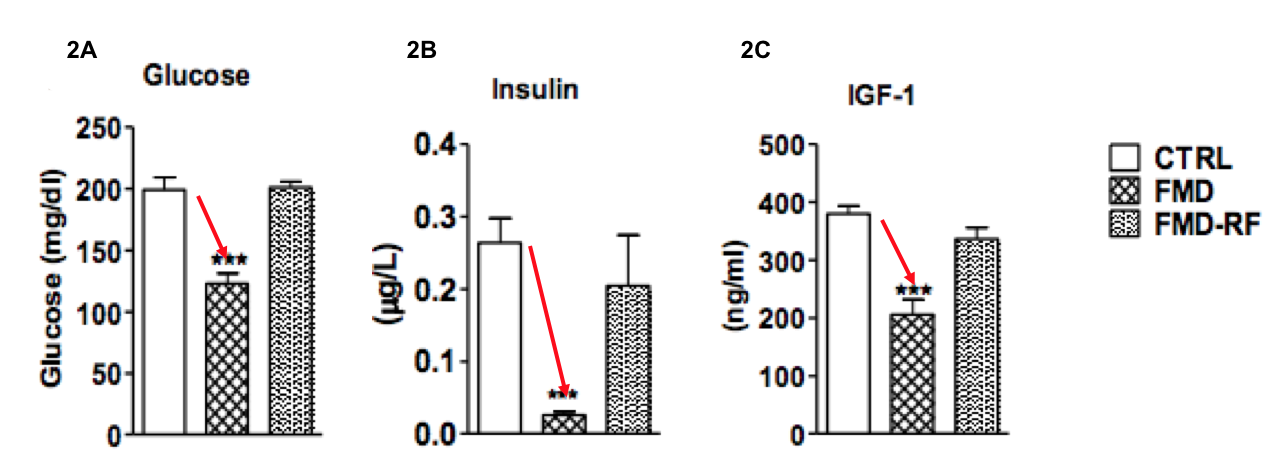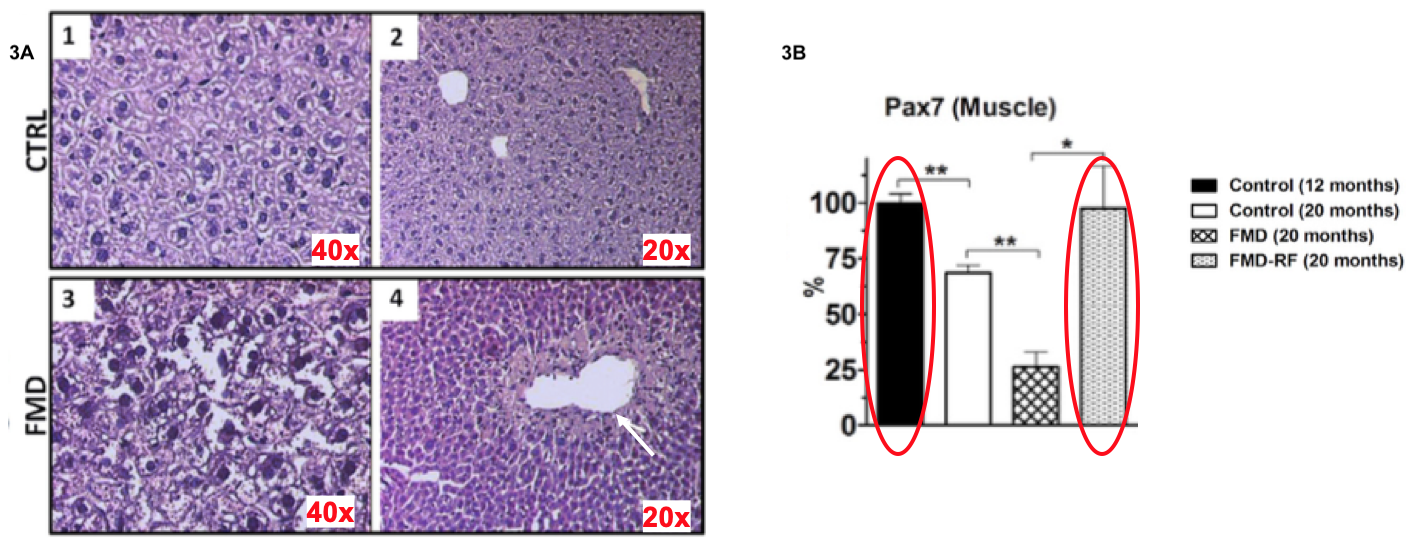20 6.3 – Effects of FMD on aged mice
Learning Objective
In this section, you will learn
- The effects on body weight, organ size, cells regeneration, and cancer incidence of FMD mice
6.3.1 Changes in the bodyweight after FMD
To investigate the body weight difference in both the control and experimental group, the FMD mice group was fed FMD for 4 days consecutively two times a month then return back to the ad libitum diet between FMD cycles, while the control group was allowed to eat freely without restriction (Brandhorst et al. 87). After 4 months of experiment, the control group gained up to ~36.6g while FMD group lost about 15% weight with severe calorie restriction at the end of each FMD cycle, shown in Figure 1A (Brandhorst et al. 88). However, upon re-feeding, the FMD group overate to compensate for the loss of calorie and their weight reversed back to the baseline level (Figure 1B) (Brandhorst et al. 88). Though the minimal difference in body weight was shown, the experiment exhibited a gradual weight loss from the FMD group after 22 months. It also showed that FMD promotes visceral fat loss without reducing the overall calorie intake, measured from the total adipose tissue (TAT) by microCT (Figure 1C) (Brandhorst et al. 88).

![]()
Figure 6.3.1 (A) Mouse body weight profile over 35 months of age. The dotted lines represent the FMD cycles. (B) Food intake measured from consumed kcal/g of the body weight per cycle. (C) Compare total adipose tissue in the control and FMD Re-feeding group. (Brandhorst et al. 88).
6.3.2 Blood glucose, serum insulin, and IGF-1 level, organ size
Blood glucose, serum insulin, and IGF-1 level were measured to examine whether FMD had any altering effects. All of the measurements were reduced by the end of the FMD cycle and returned back to the baseline after re-feeding regardless of how many cycles have fed (Brandhorst et al. 87). Under euthanasia, it was made possible to measure the weight of kidney, heart, and liver in both groups. A reduction in kidney, heart, and liver was seen, the body weight had also lowered too but these weights were gained back to a normal level at the post-FMD period (Brandhorst et al. 87).


Figure 6.3.2(A-C) Measurement of glucose (A), insulin (B) and IGF-1 (C) at 28 months old. (D-F) The weight of the kidney (D), heart (E), and Liver (F). (Brandhorst et al. 88).
6.3.3 Regeneration of the liver cells and skeletal muscle cells
When compare the liver H&E stain from the control mice to FMD mice, there were unorganized cells built up around the hepatic blood vessels after 24 hours of re-feeding, suggesting that re-feeding after FMD cycle induced hepatic regeneration(Brandhorst et al. 88). In skeletal muscle, the Pax7 expression is crucial for the survival and self-renewal of the muscle cell (Olguin et al. 769). MyoD and MyoG are the myogenic transcription factors that initiate muscle development and differentiation (Perry and Rudnick, 750). A ~40% decline in Pax7 expression at the end of the FMD cycle was observed compared to the control group, as well as a decrease in MyoG (Brandhorst et al. 89). They then exhibited a similar level as pre-FMD cycle after re-feeding. In light of these observations, the regeneration and rejuvenation of muscles are supported.

Figure 6.3.3 (A) Liver H&E stain of the control group (1, 2), and the FMD experimental group at the end of the FMD cycle (3), and 24 hours post-re-feeding (4) with different magnifications. White arrow on (4) demonstrating the clusters of unorganized cells. (B) Muscle Pax 7 expression level. (Brandhorst et al. 88).
6.3.4 Cancer incidence
In the C57BL/6 mice group, they are prone to hematopoietic tumors which were suitable to test whether FMD could intervene the deaths from cancers (Blackwell et al. 572). In the experiment, the FMD group had a 45% decrease in neoplasia and the affection rate of lymphoma has lowered from 67% to 40% (Brandhorst et al. 89).

Figure 6.3.4 (A) Measurement of all neoplasia incidence confirmed by autopsy. (B) Lymphoma incidence rate. (Brandhorst et al. 90).
